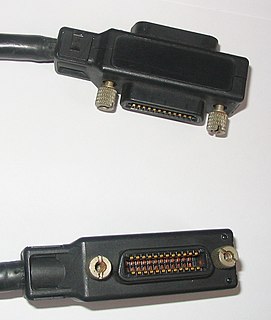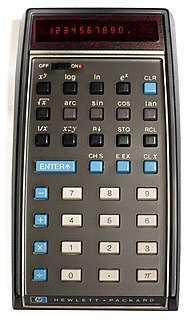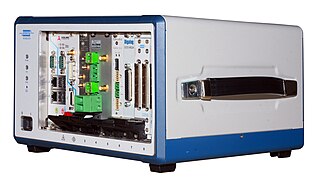This article relies largely or entirely on a single source .(February 2007) |
Instrument control consists of connecting a desktop instrument to a computer and taking measurements.
This article relies largely or entirely on a single source .(February 2007) |
Instrument control consists of connecting a desktop instrument to a computer and taking measurements.
In the late 1960s the first bus used for communication was developed by Hewlett-Packard and was called HP-IB (Hewlett-Packard Interface Bus). Since HP-IB was originally designed to only work with HP instruments, the need arose for a standard, high-speed interface for communication between instruments and controllers from a variety of vendors. This need was addressed in 1975 by the Institute of Electrical and Electronics Engineers (IEEE) published ANSI/IEEE Standard 488-1975, IEEE Standard Digital Interface for Programmable Instrumentation, which contained the electrical, mechanical, and functional specifications of an interfacing system. The standard was updated in 1987 [1] and again in 1992 [2] This bus is known by three different names, General Purpose Interface Bus (GPIB), Hewlett-Packard Interface Bus (HP-IB), and IEEE-488 Bus, and is used worldwide.
Today, there are several other buses in addition to the GPIB that can be used for instrument control. These include: Ethernet, USB, Serial, PCI, and PXI.
In addition to the hardware bus to control an instrument, software for the PC is also needed. Virtual Instrument Software Architecture, or VISA, was developed by the VME eXtensions for Instrumentation (VXI) plug and play Systems Alliance as a specification for I/O software. VISA was a step toward industry-wide software compatibility. The VISA specification defines a software standard for VXI, and for GPIB, serial, Ethernet and other interfaces. More than 35 of the largest instrumentation companies in the industry endorse VISA as the standard. The alliance created distinct frameworks by grouping the most popular operating systems, application development environments, and programming languages and defined in-depth specifications to guarantee interoperability of components within each framework.
Instruments can be programmed by sending and receiving text based SCPI commands or by using an instrument driver . To ease the programming of instruments, many instruments are provided with industry standard instrument drivers such as VXIplug&play or IVI. These drivers require a VISA library to be to installed on the PC. IVI instrument drivers were designed to enable interchangeability of instruments in a manufacturing setting where automation and reduced down-time are important, but they are often used in other applications as well.
Application development environments can support instrument control by supporting VISA and industry standard instrument drivers. Environments supporting VISA include LabVIEW, LabWindows/CVI, MATLAB, and VEE. Furthermore, the VISA library can support programming languages like C, C++, C#, Python and others.

Data acquisition is the process of sampling signals that measure real world physical conditions and converting the resulting samples into digital numeric values that can be manipulated by a computer. Data acquisition systems, abbreviated by the initialisms DAS or DAQ, typically convert analog waveforms into digital values for processing. The components of data acquisition systems include:

IEEE 488 is a short-range digital communications 8-bit parallel multi-master interface bus specification developed by Hewlett-Packard as HP-IB. It subsequently became the subject of several standards, and is generically known as GPIB.

Electronic test equipment is used to create signals and capture responses from electronic devices under test (DUTs). In this way, the proper operation of the DUT can be proven or faults in the device can be traced. Use of electronic test equipment is essential to any serious work on electronics systems.
LAN eXtensions for Instrumentation (LXI) is a standard developed by the LXI Consortium, a consortium that maintains the LXI specification and promotes the LXI Standard. The LXI standard defines the communication protocols for instrumentation and data acquisition systems using Ethernet. Ethernet is a ubiquitous communication standard providing a versatile interface, the LXI standard describes how to use the Ethernet standards for test and measurement applications in a way that promotes simple interoperability between instruments. The LXI Consortium ensures LXI compliant instrumentation developed by various vendors work together with no communication or setup issues. The LXI Consortium ensures that the LXI standard complements other test and measurement control systems, such as GPIB and PXI systems.

The HP-35 was Hewlett-Packard's first pocket calculator and the world's first scientific pocket calculator: a calculator with trigonometric and exponential functions. It was introduced in 1972.

The HP-IL, was a short-range interconnection bus or network introduced by Hewlett-Packard in the early 1980s. It enabled several devices such as printers, floppy disk drives, tape readers, etc. to be connected to programmable calculators such as the HP-41C, HP-71B and HP-75C/D, the 80-series and HP-110 computers, as well as generic ISA bus based PCs.
A software requirements specification (SRS) is a description of a software system to be developed. It is modeled after business requirements specification(CONOPS), also known as a stakeholder requirements specification (StRS). The software requirements specification lays out functional and non-functional requirements, and it may include a set of use cases that describe user interactions that the software must provide to the user for perfect interaction.
The VXI bus architecture is an open standard platform for automated test based upon VMEbus. VXI stands for VME eXtensions for Instrumentation, defining additional bus lines for timing and triggering as well as mechanical requirements and standard protocols for configuration, message-based communication, multi-chassis extension, and other features. In 2004, the 2eVME extension was added to the VXI bus specification, giving it a maximum data rate of 160 MB/s.

Automatic test equipment or automated test equipment (ATE) is any apparatus that performs tests on a device, known as the device under test (DUT), equipment under test (EUT) or unit under test (UUT), using automation to quickly perform measurements and evaluate the test results. An ATE can be a simple computer-controlled digital multimeter, or a complicated system containing dozens of complex test instruments capable of automatically testing and diagnosing faults in sophisticated electronic packaged parts or on wafer testing, including system on chips and integrated circuits.
A test plan is a document detailing the objectives, resources, and processes for a specific test for a software or hardware product. The plan typically contains a detailed understanding of the eventual workflow.
Keysight VEE is a graphical dataflow programming software development environment from Keysight Technologies for automated test, measurement, data analysis and reporting. VEE originally stood for Visual Engineering Environment and developed by HP designated as HP VEE; it has since been officially renamed to Keysight VEE. Keysight VEE has been widely used in various industries, serving the entire stage of a product lifecycle, from design, validation to manufacturing. It is optimized in instrument control and automation with test and measurement devices such as data acquisition instruments like digital voltmeters and oscilloscopes, and source devices like signal generators and programmable power supplies.
Virtual instrument software architecture (VISA) is a widely used application programming interface (API) in the test and measurement (T&M) industry for communicating with instruments from a computer. VISA is an industry standard implemented by several T&M companies, such as, Anritsu, Bustec, Keysight Technologies, Kikusui, National Instruments, Rohde & Schwarz, and Tektronix.

PCI eXtensions for Instrumentation (PXI) is one of several modular electronic instrumentation platforms in current use. These platforms are used as a basis for building electronic test equipment, automation systems, and modular laboratory instruments. PXI is based on industry-standard computer buses and permits flexibility in building equipment. Often modules are fitted with custom software to manage the system.
A software design description is a written description of a software product, that a software designer writes in order to give a software development team overall guidance to the architecture of the software project. An SDD usually accompanies an architecture diagram with pointers to detailed feature specifications of smaller pieces of the design. Practically, the description is required to coordinate a large team under a single vision, needs to be a stable reference, and outline all parts of the software and how they will work.

The Standard Commands for Programmable Instruments defines a standard for syntax and commands to use in controlling programmable test and measurement devices, such as automatic test equipment and electronic test equipment.

The HP 64000 Logic Development System, introduced 17 September 1979, is a tool for developing hardware and software for products based on commercial microprocessors from a variety of manufacturers. The systems assisted software development with assemblers and compilers for Pascal and C, provided hardware for in-circuit emulation of processors and memory, had debugging tools including logic analysis hardware, and a programmable read-only memory (PROM) chip programmer. A wide variety of optional cards and software were available tailored to particular microprocessors. When introduced the HP 64000 had two distinguishing characteristics. First, unlike most microprocessor development systems of the day, such as the Intel Intellec and Motorola EXORciser, it was not dedicated to a particular manufacturer's microprocessors, and second, it was designed such that up to six workstations would be connected via the HP-IB (IEEE-488) instrumentation bus to a common hard drive and printer to form a tightly integrated network.
M-Modules are a mezzanine standard mainly used in industrial computers. Being mezzanines, they are always plugged on a carrier PCB that supports this format. The modules communicate with their carrier over a dedicated bus, and can have all kinds of special functions.
An instrument driver, in the context of test and measurement (T&M) application development, is a set of software routines that simplifies remote instrument control. Instrument drivers are specified by the IVI Foundation and define an I/O abstraction layer using the virtual instrument software architecture (VISA). The VISA hardware abstraction layer provides an interface-independent communication channel to T&M instruments. Furthermore, the instrument drivers encapsulate the Standard Commands for Programmable Instruments (SCPI) commands, which are an ASCII-based set of commands for reading and writing instrument settings and measurement data. This standard allows an abstract way of using various programming languages to program remote-control applications instead of using SCPI commands. An instrument driver usually has a well-defined API.
Bustec is a company that designs and manufactures instrumentation for high-performance data acquisition and instrument control. The company's products serve applications that include engine testing, automotive and missile testing, wind tunnel data acquisition and control, acoustics, vibration applications, aircraft component testing and more. Headquarters is located in Shannon, Co. Clare, Ireland.
HiSLIP is a TCP/IP-based protocol for remote instrument control of LAN-based test and measurement instruments. It was specified by the IVI Foundation and is intended to replace the older VXI-11 protocol. Like VXI-11, HiSLIP is normally used via a library that implements the VISA API. Version 1.4 of the LAN eXtensions for Instrumentation (LXI) standard recommends HiSLIP as “LXI HiSLIP Extended Function for LXI based instrumentation”.
This article needs additional citations for verification .(February 2007) (Learn how and when to remove this template message) |